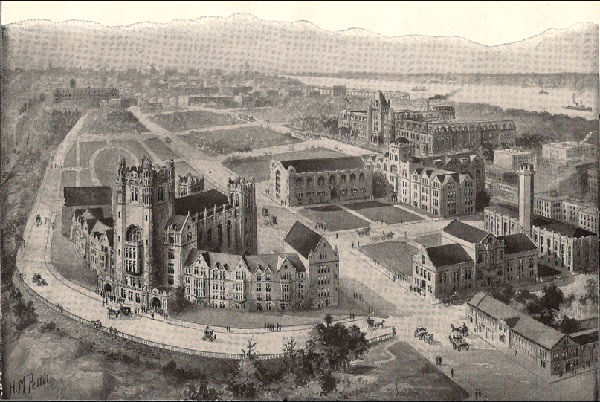A great rare etching of City College of New York was originally founded as the Free Academy of the City of New York at St. Nicolas Terrace to Amsterdam Avenue, W. 140th to West 138th Streets in post colonial Harlem in upper Manhattan in 1847 by wealthy businessman and president of the Board of Education, Townsend Harris.
Townsend Harris establish diplomatic relations between the United States and Japan. Ratified by a statewide referendum, it was established to provide children of immigrants and the poor access to free higher education based on academic merit alone.
Dr. Horace Webster, a West Point graduate, was the first president of the Free Academy. When it opened on, January 21, 1849, Webster said:
“The experiment is to be tried, whether the children of the people, the children of the whole people, can be educated; and whether an institution of the highest grade, can be successfully controlled by the popular will, not by the privileged few.”
City College thus became one of the nation’s great democratic experiments, and it remains today one of its great democratic achievements. Even in its early years, the Free Academy showed tolerance for diversity, especially in comparison to the private universities in New York City.
In 1866, the Free Academy, a men’s institution, was renamed the College of the City of New York. In 1867 the academic senate, the first student government in the nation, was formed. General Alexander S. Webb, one of the Union’s heroes at the battle of Gettysburg, also presided over the College in the 19th century.
In the early 1900s, President John H. Finley gave the College a more secular orientation by abolishing mandatory chapel attendance a change that occurred at a time when more Jewish students were enrolling in the College.
In 1907, City College moved to what was then called Manhattanville, now the heart of Harlem, to the Neo-Gothic campus designed by George Browne Post, the architect of the Stock Exchange.Today, those buildings are landmarked, and the campus has expanded to 36 tree-lined acres.
In 1930, CCNY admitted women for the first time, but only to graduate programs. In 1951, the entire institution became coeducational. In the years when top-flight private schools were restricted to the children of the Protestant establishment, thousands of brilliant individuals (including Jewish students) attended City College because they had no other option. City’s academic excellence and status as a working-class school earned it the titles “Harvard of the Proletariat,” “the poor man’s Harvard,” and “Harvard-on-the-Hudson.” Ten CCNY graduates went on to win Nobel Prizes. Like City students today, they were the children of immigrants and the working class, and often the first of their families to go to College.
The Baruch School of Business at the City College of New York, named after CCNY alumnus Bernard Baruch, opened on 23rd Street in Manhattan in 1919, and became Baruch College in 1961 with the establishment of The City University of New York – now the largest public urban university system in the United States, and consisting of 24 institutions, including its flagship, City College.
Become a Harlem Insider!
By submitting this form, you are consenting to receive marketing emails from: . You can revoke your consent to receive emails at any time by using the SafeUnsubscribe® link, found at the bottom of every email. Emails are serviced by Constant Contact









